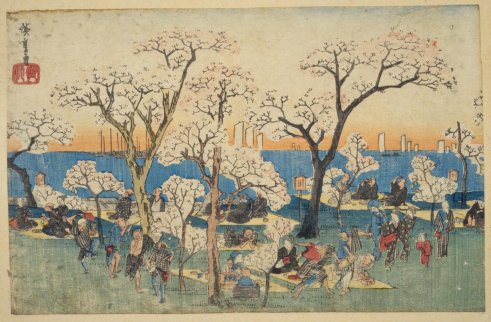 「江都名所 御殿山遊興」 広重 国立国会図書館 所蔵
「江都名所 御殿山遊興」 広重 国立国会図書館 所蔵「花見(お花見)」は、「桜」や「梅」、「桃」の花を鑑賞して春の到来を祝う日本古来の風習です。
「桜」の花は、「菊」と共に日本の「国花」と言われています。
“樱花”与“菊花”一起被称为日本的“国花”。
「菊」は「皇室」の象徴としての意味があります。
“菊”有“皇室”的象征意义。
毎年春になると日本中で「桜」の花がほころびます。
Every spring, “Sakura 桜 the Cherry trees” burst into bloom all
over Japan.
日本有300种以上的“樱花”。
In Japan,
there are more than 300 varieties of “Sakura Cherry tree” around the country.
很多日本人一提到“赏花”,就会联想到“樱花”。
古代の人々は、亡くなった人を桜の木の下に埋葬すると、その魂が「桜の花」となって春に蘇ると考えました。
日本では、春の始まりを祝う「祭り」や、新しい作物の植付けを祝う「祭り」が開催されてきました。
“樱花”是插秧、播种等农业的指标。
“Sakura Cherry blossom” was an indicator of agriculture such as rice planting
and sowing.
田植えや種まきの後、古代人は「桜」の花の下でピクニックをする習慣がありました。
做插秧、播种等后,古代人有去野外和山丘吃饭的习惯。
たぶん、「花見」はこの習慣に由来すると思われます。
“赏花”大概就是由这个习惯演变而来的吧。
7世紀頃(「飛鳥時代(592-710)」)に、「遣唐使」が中国から「梅」を持ち帰ったと考えられています。
据推测在“飞鸟时代(592-710)”,“遣唐使”从中国带回了“梅花”。
It is
thought that around 7th century (during the “Asuka-jidai 飛鳥時代 Period (592-710)”), “Kentōshi 遣唐使 Missions to the Tang
dynasty in China” brought back “Ume Plum tree” from China.
8世紀頃(「奈良時代(710-794)」は、中国の文化の影響で、貴族たちが盛んに「梅」を愛でました。
In 8th century
(“Nara-jidai 奈良時代 Period (710-794)”), nobles loved “Ume
Plum blossom” with the influence of culture from China.
10世紀初頭には、「桜」が和歌の重要なモチーフの一つになりました。
在10世纪初,“樱花”成为了“和歌”的重要主题之一。
In the early 10th century, “Sakura Cherry blossom” became one of the important motifs of “Waka 和歌 Tanka poetry”.
貴族たちは、美しく咲いたかと思えばほどなく散ってしまう「桜」に、儚い自分の人生を重ね合わせました。
贵族们,把美丽却短暂的「樱花」和自己虚幻的人生重叠在了一起。
The nobles
felt their own mortal lives just like “Sakura Cherry blossom” that bloom beautifully
but fall down from trees before long.
日本人は咲いた花の美しさだけでなく、散りゆく姿にも美しさを感じます。
日本人不仅欣赏樱花绽放的美,也喜爱其凋零的美。
Japanese feels beauty not only in blooming flowers but also in the way
they fall down from trees to the ground.
18世紀以降、「花見」は一般庶民の娯楽として広く行われるようになりました。
到了“江户时代”,“赏花”作为一般平民的娱乐形式而流行。
From 18th
century, “Hanami Sakura Viewing” was held as the recreation for the common
people.
第8代将軍「徳川吉宗」は、「隅田堤」や「飛鳥山」、「御殿山」などに「桜」を植えました。
第8代将军“德川吉宗”于1720(享保5)年在“隅田堤”,“飞鸟山”和“御殿山”等地种植“樱花”,然后奖励平民游玩。
The 8th Shogun “Tokugawa Yoshimune 徳川吉宗” planted “Sakura
Cherry tree” on “Sumida-tsutsumi 隅田堤 River bank (near
Asakusa 浅草)”, Asuka-yama 飛鳥山 Hill (near Ōji 王子)”, “Goten-yama 御殿山Hill (near Shinagawa 品川)”, and other
places.
そして、彼は庶民に行楽を奨励しました。
And he encouraged
the common people excursion.
人々は「桜」の花の下で、「弁当」を食べたり、お酒を飲んだり、歌ったり、踊ったりしました。
人们在樱花树下,吃便当,喝酒,唱歌,跳舞。
Under “Sakura Cherry blossom”, people ate “Bentō 弁当 Box meal”, drank Sake, sang and danced.
花を鑑賞するよりも、食事を楽しむ情景を冷笑的に表現したことわざの「花より団子」です。
“比花更喜欢团子”这一“谚语”略带揶揄地表现了一般老百姓关心的生计。
他の日本の伝統的な習慣と異なり、工業化や近代化が進んでも、「花見」習慣はなくなりませんでした。
和其他日本传统习惯不同,“赏花”的人气随着工业化和现代化而高涨。
Unlike so many other of Japanese old customs, the popularity of “Hanami”
had increased with industrialization and modernization.
「桜」を見ながらお酒を飲む賑やかなパーティが「花見」と呼ばれ、日本の春の「風物詩」になっています。
一边赏樱花一边喝酒的热闹的派对被称作“赏花”,成为日本春天的“季节的象征”。
The cheerful party that people can drink while looking at “Sakura Cherry
blossom” is called “Hanami” and they have become Seasonal event of spring
in Japan.
 「江都名所 御殿山遊興」 広重 国立国会図書館 所蔵
「江都名所 御殿山遊興」 広重 国立国会図書館 所蔵
「江戸時代」に「桜」の品種改良が盛んに行なわれました。
“江户时代”盛行“樱花”的品种改良。
“染井吉野”是代表日本性的“樱花”之一。
「江戸時代」末期(19世紀半ば)に「染井村」の植木屋によって育成されました。
“江户时代”末期(19世纪中叶)由“染井村”的花匠培育而成。
他们把以“樱花”的名胜而闻名的“大和”(奈良)的“吉野山”命名为“吉野”或者“吉野樱”来销售。
「ソメイヨシノ」は、二つの桜を交配させた園芸品種です。
“Somei
Yoshino” is a horticultural variety born by crossing two “Sakura tree”.
一つは、日本から朝鮮半島、中国に広く分布する「エドヒガン」です。
One is “Edo-higan
江戸彼岸” that is distributed widely throughout Japan, the Korean Peninsula
and China.
もう一つは、日本固有の品種である「オオシマザクラ」です。
“染井吉野”是由“江户彼岸”和日本固有种的“大岛樱花”的杂交成的园艺品种。
根据遗传因子研究的结果,判明了染井吉野是把单一的树克隆繁殖的。
日本各地的“染井吉野”的树都是嫁接繁殖的。
「江戸時代」末期(19世紀半ば)に「染井村」の植木屋によって育成されました。
江户时代末期(19世纪中叶),“染井吉野”由“染井村”的花匠培育而成。
彼らは、「桜」の名所として名高い「大和」(奈良)の「吉野山」にちなんで「吉野」または「吉野桜」という名前をつけて売っていました。
他们以樱花胜地闻名的“大和”(奈良)的“吉野山”命名樱花来销售,称为“吉野”或者“吉野樱”。
「ソメイヨシノ」は成長が早く、若い木から花が咲き、豪華に見えます。
“染井吉野”生长快,青年期的树上就开花,看起来很豪华绚烂。
「明治時代」の中頃から全国で数多く植えられました。
「ソメイヨシノ」は「エドヒガン」の特色を引き継ぎ、葉が出る前に花が咲きます。
和“江户彼岸”一样,在长出叶子之前先开花。
“Some
Yoshino” inherits the characteristics of “Edo-higan”, and flowers bloom before
leaves come out.
満開(8割以上が開花)時には花だけが密生して樹体全体を覆います。
盛开(8成以上开花)时只有花密集生长于树枝,覆盖整个树冠。
蕾は濃い赤に見えますが、咲き始めの花色は淡紅色で、満開になると白色に近づきます。
The buds appear dark red, but the flower color that begins to bloom is
light red and approaches white when it is in full bloom.
「ソメイヨシノ」の花は、「オオシマザクラ」の特色を引き継ぎ、大きく派手で、整った形をしています。
The flowers of "Somei Yoshino" inherit the characteristics of “Ōshima-zakura”, and are large, flashy and well-shaped.
果实很小,有少许甜味,但苦味和酸味很强,不适合食用。
同じ遺伝子を持つため、気候条件が似ている地域の「ソメイヨシノ」は一緒に開花します。
拥有相同基因的“染井吉野”,气候条件相同的地区一起开花。
Because of same gene, “Somei Yoshino”, in areas with similar climatic conditions,
will bloom together.
「ソメイヨシノ」が開花する地域を線でつないだ「開花前線」は、梅雨前線のように北上していきます。
像梅雨前线一样北上。
The “Blooming Front”, which connects the areas where “Some Yoshino” blooms, moves northward like the rainy season front.
民间气象公司宣布各地区预计开花日期,成为国民的话题。
从3月到5月,报纸、电视上将地域的开花状况从“九州”到“北海道”,每天报道。
しかし、東京都の小石川植物園には1877年ごろに植樹された樹齢約140年の樹があります。
进入21世纪,「染井吉野」的衰退变得显著,也产生了其寿命为60年的说法。
However, at “Koishikawa Botanical Garden” in Tokyo, there is a tree that
was planted around 1877 and is about 140-year-old.
また、青森県の「弘前城」(弘前公園)には1882年に植樹された樹齢130年を超える樹があります。
还有青森县的“弘前城”(弘前公园)有1882年种植的树龄超过130年的树。
And at “Hirosaki-jō 弘前城 Castle” (Hirosaki-kōen Park) in Aomori
Prefecture, there is a tree that was planted in 1882 and are over 130 years old.
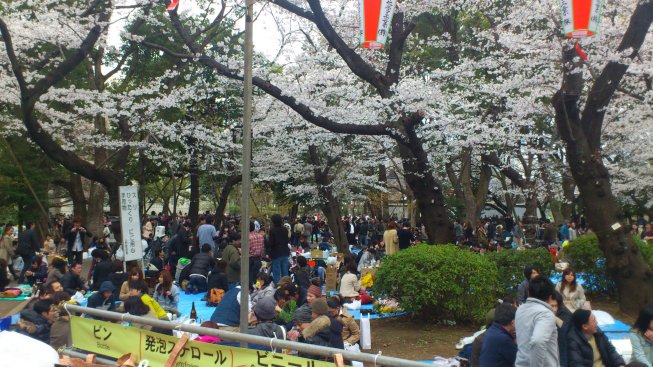 上野恩賜公園
上野恩賜公園
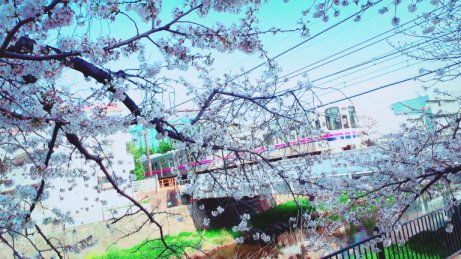 Photo:Suzuki Kouichi
Photo:Suzuki Kouichi
オオシマザクラ
「オオシマザクラ(大島桜)」は日本の固有種で、日本に10種あるサクラ属基本野生種のうちの一つです。
“大岛樱”是日本的固有品种,是日本10种樱花属基本野生品种之一。
“Ōshima-zakura 大島桜 Cherry tree” is an endemic species of Japan and is one of the 10 basic wild species of the genus “Sakura Cherry tree” in Japan.
高达15米的落叶高木。
It is a
deciduous tree with a height of 15m.
叶子长5~10cm左右,晚秋时变成红叶。
The
leaves are about 5-10cm in length and turn in late autumn.
与叶子一起,从枝头的顶端生长出数个大型的有淡淡芳香的白色花朵。
Along
with the growth of the leaves, several large and white flowers come out with a
light fragrance from the tip of the branch.
初夏にかけて結実し、十分に熟した果実は食べられますが、えぐみが強く実も小さいため、食用として流通することはありません。
到初夏结实,充分成熟了的果实能吃,不过,因为果实碱性很强,果实也很小,没有作为食用品种流通。
“Ōshima-zakura Cherry tree” are fruited in early summer and you can eat
fully ripe fruits, but they are not able to sell because they are very
bitter and small.
因为叶子没有毛,所以把嫩叶用盐腌制后作为“樱饼”的材料。
Because
the leaves have no down, the young leaves are salted and used for “Sakura-mochi
桜餅 Wagashi”.
独特的香味由来“Coumarin”为主的成分。
The
origin of the unique fragrance is mainly the component called coumarin.
秋の「七草」の一つである「フジバカマ」と同様の香りです。
Coumarin
is the same as “Fujibakama 藤袴 Boneset” that is
one of the autumn “Nana-kusa 七草 Seven herb”.
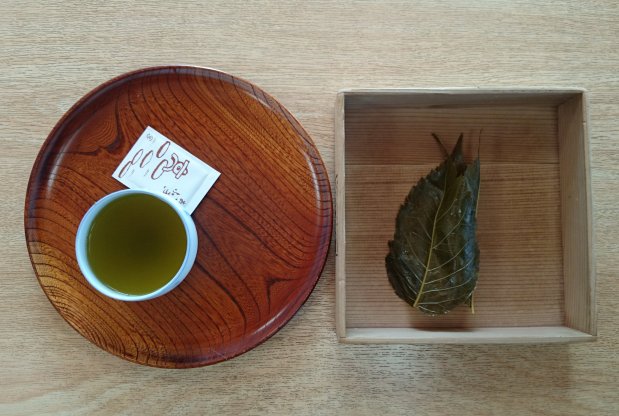
「エドヒガン(江戸彼岸)」は、「桜」の野生種の一つで、中国や朝鮮半島にも分布しています。
“Edo-higan 江戸彼岸” is one of the wild species of “Sakura”, and is disributed in China and
the Korean Peninsula.
在关东地区常见,因为在春分时节(日语称之为“彼岸”)开花,所以取了这个名字。
This name was given because it is often seen in the “Kantō 関東” region and
単に「ヒガンザクラ(彼岸桜)」とも呼ばれます。
也被叫做“彼岸樱”。
It is simply called “Higan-zakura 彼岸桜”.
「ウバヒガン(姥彼岸)」という名前は、花が咲く時に葉がないので、「歯がない姥」が由来です。
“姥彼岸”这个名字是由来是,花开时树枝上没有叶子,就像“没有牙齿的老奶奶”。日语中“叶子”和“牙齿”的发音都是“Ha”。
The name “Uba-higan 姥彼岸” is derived from “Ha ga nai 歯がないToothless” because there are “Ha ga nai 葉がないNo leaves” when the flower blooms.
「姥桜」は、女盛りを過ぎてもなお美しい女性のことです。
“Uba-zakura
姥桜” means a woman who is over the prime of womanhood, but is still
beautiful.
「エドヒガン」は落葉高木で、樹高はおおよそ15m-25mです。
“江户彼岸”是落叶高木,树高约15-25米。
“Edo-higan” is a deciduous tree, and the tree height is approximately 15m-25m.
比“染井吉野”开花早。
Flowers
begin to bloom sooner than “Somei Yoshino”.
“Edo-higan” blooms from pale red to white flowers before the leaves.
在“樱花”中是非常长寿的。
The life of “Edo-higan” is very long among “Sakura”.
山梨県の「山高神代桜」は樹齢2000年を超え、岐阜県の「淡墨桜」は樹齢1500年を超えると言われています。
“Yanataka Jindaizakura” in Yamananshi prefecture is said to be over 2000
years, and “Usuzumizakura” in Gif prefecture is said to be over 1500 years.
因为其开花多的特性,因此被作为各种品种的母树。
“Edohigan” is used as a mother seed of many varieties due to its many flowering
characteristics.
也作为“染井吉野”的母树被熟知。
It is
also known as the parent of “Somei Yoshino”.
「ヤマザクラ(山桜)」は、日本に10 種あるサクラ属の基本野生種の中でも代表的な種です。
“Yama-zakura 山桜” is one of the 10 basic wild species of the genus Sakura in Japan.
在“和歌”中也被大量吟诵,“吉野之樱”本来指的就是这个“山樱”。
Many “Yamazakura”
were also written in “Waka 和歌 Japanese Poem”,
the “Yoshino no saura 吉野の桜 Sakura in Yoshino” originally refers to this “Yama-zakura”.
“山樱”是作为日本的象征的“樱花”,不过,台湾,朝鲜半岛也有分布。
Although it is a symbol of Japan, it is also distributed in Taiwan and
Korean peninsula.
在樱花中“山樱”的寿命比较长,有树高超过30米的大树。
“Yama-zakura” has a long lifespan in “Sakura” and sometimes become large trees that exceed 30m in height.
Some “Yamazakura”
are over 500 years old.
也有很多把“山樱”作为原种进行改良的樱花品种。
There are many species that have been bred using “Yama-zakura” as the original
species.
多数情况下,叶和花同时生长,这是和“染井吉野”最大的区别。
In many
cases, leaf buds and flower buds open at the same time, which is a major
feature that distinguishes them from “Somei Yoshino”.
It is
also popular as a furniture material, and the bark is used for craftwork.
「サトザクラ(里桜)」は、「オオシマザクラ」を基にして開発されたと考えられる園芸品種です。
“Sato-zakura 里桜” is a horticultural variety thought to have been developed based on
“Ōshima-zakura 大島桜”
将“大岛樱”与“山樱”、“江户彼岸樱”、“霞樱”、“豆樱”等品种杂交。
“Ōshima-zakura” is multiplied by “Yama-zakura”, “Edo-higan”, “Kasumi-zakura
霞桜”, “Mame-zakura 豆桜” and so on.
The history of “Sato-zakura” is said to have been from the “Heian-jidai
平安時代 Period” when people began planting “Sakura” in their gardens.
Variety improvements such as artificial hybrid and mutation, and selection and breeding from the wild have been continued.
现在有200种以上的“里樱”。
It has been improved to look good for ornamental purposes, and there are
many types of double and weeping blooms.
「カンヒザクラ(寒緋桜)」は、「ヒカンザクラ(緋寒桜)」または「タイワンザクラ(台湾桜)とも呼ばれます。
寒绯樱也被称为“绯寒樱”或者“台湾樱”。
它和彼岸樱、江户彼岸樱不同。
吊钟状的花向下开放,在中国也被称为钟花樱。
It is
called “鐘花桜花Zhonghua-yinghua Bell cherry” in China
because the bell-shaped flower blooms downward.
其特征是花瓣不会单独凋零,而是连同花萼一起掉落。
There is a characteristic that the petals do not fall separately but fall with calyx.
“Kanhi-zakura 寒緋桜” is distributed from southern China to Taiwan and are wild in
Okinawa.
在冲绳,樱花指的就是寒绯樱。
You can make fruit wine by putting the fruits (cherries) on “Awamori 泡盛 Rice brandy”.
“Kawazu-zakukura 河津桜” of “Sato-zakura” is a natural hybrid of “Kanhi-zakura” and “Ōshima-zakura”.
1月下旬至2月开花的早春樱花。
It is an early blooming cherry blossom that blooms from late January to
February.
比染井吉野的粉红色深,花期有一个月左右。
It has a darker pink color than "Somei Yoshino" and has a flowering period of about a month.
「ヨウコウ(陽光)」は「アマギヨシノ(天城吉野)」と「カンヒザクラ(寒緋桜)」を交雑させた園芸品種です。
阳光樱是天城吉野樱和寒绯樱杂交产生的园艺品种。
Made by “Mr.Takaoka Masa-aki 高岡正明”, a school teacher during World War
II, after 25 years of trial and error.
战后,他为了给战死的学生们祈福,从冲绳至北海道,向日本各地赠送樱花。
天城吉野樱来自于染井吉野樱,抗寒是其特征。
“Amagi Yoshino” is derived from “Somei Yoshino” and has a strong feature against the cold.
寒绯樱原产于台湾和中国南部,耐热是其特征。
The tree shape is broad egg-shaped, and a single large flower with bright
pink flowers blooms faster than “Somei Yoshino”.
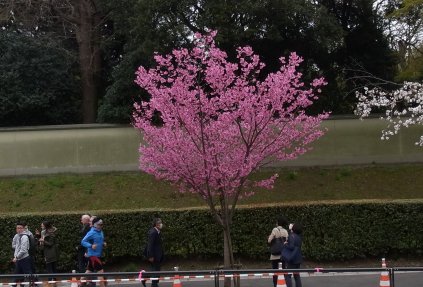 代官町通り
代官町通り
「シュゼンジカンザクラ(修善寺寒桜)」は、「カンヒザクラ」と「オオシマザクラ」の交雑種と考えられています。
There is
an old tree at “Shuzen-ji 修善寺 Temple” in
“Shuzenji-machi 修善寺町 Town”, Shizuoka Prefecture.
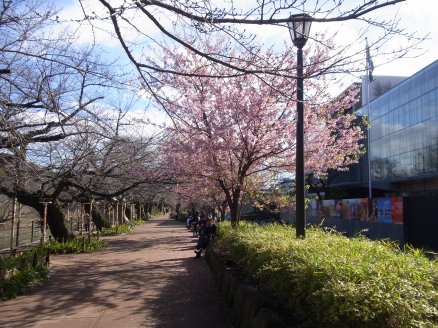 千鳥ヶ淵緑道
千鳥ヶ淵緑道
「シダレザクラ(枝垂桜)」は、「エドヒガン」の系の品種で、「ベニシダレ」や「ヤエベニシダレ」やなどが有名です。
枝垂樱是江户彼岸樱系的品种,红枝垂樱和八重红枝垂樱等品种有名。
作为日本三大樱花而被熟知的三春泷樱是红枝垂樱。
Known as one of Japan's three largest cherry blossoms, “Miharu no Takizakura 三春の滝桜” is “Beni-shidare”.
That tree is over 1000 years old and is said to be the largest giant tree
in Japan as “Shidare-zakura Weeping cherry tree”.
“Shidare-zakura” is also used as a generic term for “Sakura” with soft branches.
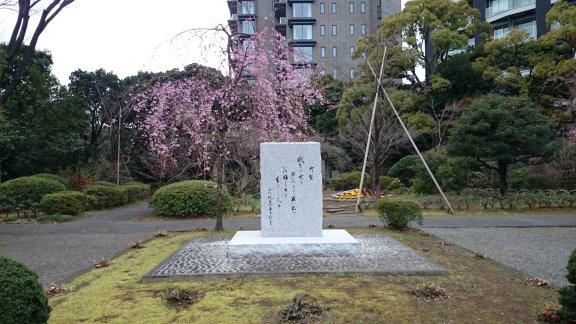 千鳥ヶ淵戦没者墓苑
千鳥ヶ淵戦没者墓苑